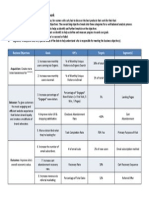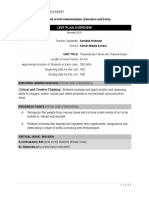Lessonplan 2
Uploaded by
api-310441633Lessonplan 2
Uploaded by
api-310441633Service Learning Lesson Plan
Title: Creating art with Zentangles
Lesson Idea and
Relevance: What are you
going to teach and why is this
lesson of importance to your
students? How is it relevant to
students of this age and
background?
1.
Group/Date: Cooper House, March 7, 2016
How to use drawing techniques to create repetition and pattern in their designs
Many students enjoy simple mark making and repeating shapes. Zentangles will
help them combine or expand these acts into a piece of art.
Essential Understanding (s): What are the big ideas? What specific
Essential Question (s): What provocative questions will foster
understandings about them are desired?
inquiry, understanding, and transfer of learning?
Artists can use the expressive features and characteristics of 1.
art to create art.
2.
3.
Why would an artist draw the same shape more than once?
How can an artist fill space using repetition?
Use a quick field trip to find repeated shapes that create
pattern in the environment. (Outside? In the room?)
Outcomes - Students will be able to...What key knowledge and skills will students acquire as a result of this unit? ...Art history and culture;
expressive features and characteristics of art; art materials, tools, and techniques? What should they eventually be able to do as a result of such knowledge and
skill? ...Compare and contrast art work; analyze sketches?
Students will be able to
1.
2.
3.
4.
5.
Students will be able to recognize pattern and repetition in the real world
Students will be able to explain what repetition and pattern are and how they can be used in art.
Students will be able to draw with line, shape, and value to create repetition or pattern.
Students will be able to create a composition using repetition or pattern.
Students will be able to analyze their work and explain the use of repetition or pattern in their design.
Student Reflective Activity: Through what authentic performance
Assessment Instrument (s):
task(s) will students demonstrate the desired understandings? How will
students reflect upon and self-assess their learning?
understanding be judged?
Artist Talk
Students will discuss their works, and explain their process.
They will explain what patterns they used first, and how they
chose to go about their overall composition in order to convey
an idea.
Exceeds expectations: Students create zentangles, using a
variety of patterns to create an image of their own invention
Meets expectations: Students use at least 2 patterns to fill in a
printed zentangle
Developing: Students practice drawing patterns, but dont fill
them into an image.
By what criteria will performances of
Pre-assessment:
How will you help the students know where the unit is going and what is expected? Help the teacher know where the students are
coming from (prior knowledge, interests)?
1.
2.
3.
4.
Have you ever heard of Zentangles?
What is the general definition of repetition when it comes to art?
How can an artist use repetition and pattern in their work?
What patterns interest you to try?
Motivation:
How will you hook all students and hold their interest?
Demonstrate simple pattern ideas and allow them to try a few
on their own. Students will sit at the tables in the front and see
a demonstration of what Zentangles are on the whiteboard.
They then will get to try up to 10 different patterns: Cross
hatching, stippling, bubbles, wave, triangles and 5 patterns of
their choice.
Ideation:
How will you equip students, help them experience the key
ideas, and explore the issues to generate ideas for their art work?
Students will get to test out a few basic patterns as well as a
few that interest them.
Discuss how pattern and repetition can help an artist fill
space and convey an idea.
Examples will be displayed on the board so students can see
how to fill space through pattern.
Procedures: How is the lesson organized to maximize initial and sustained engagement as well as effective learning? Provide opportunities to rethink and
revise their understandings and work? Allow students to evaluate their work and its implications? Include literacy and numeracy?
1. Greet students, talk to them, intro activity (15 minutes)
2. Introduce and briefly demo zentangles (20 minutes)
a. Show students how to draw a zentangle (on paper and with clay)
Show examples of patterns they can draw (triangles, lines, circles)
Demonstrate how the patterns can be placed into different shapes to make an image
Show students how they can draw into slabs of clay to make an image
b. Show examples of zentangles
c. Let them play with and explore zentangles
d. Show students more techniques on an individual basis:
more complex patterns
zentangles in different shapes
rolling coils of clay to create lines
cutting out shapes
3. Regroup to talk about their work (10 minutes)
a. Ask students which processes and techniques they prefer and why
ex:What did you do to make that pattern? What does is look like? Which did you like using the most?
How could you use the patterns to make something new?
b. Discuss how they used the clay
How did your design change when you used clay? How did you make lines with the clay?
4. Prompt students to create an object from the shapes they have made (25 minutes)
a. Work with individuals to identify what they want to create or what their image is looking like
b. Let the shapes they were playing with direct what they make
c. Show examples of landscapes, buildings or figures that fit with what they choose to make
d. Share students work and discoveries with the group as they arise
5. Regroup to discuss and share everyones art (15 minutes)
6. Clean up (5 minutes)
Materials and Resources: What is needed to complete the learning plan? List materials and resources in a bulleted format.
Paper
Markers
Pens
Colored pencils
Clay
Aprons
Gloves
Rolling pins
Clay tools
Examples of zentangles
Preparation and Safety: What do you need to prepare for this experience? What safety issues need to be addressed? List steps of preparation and
safety in a bulleted format.
Set up materials beforehand
Dont assign seats-ask students to sit at the table with the medium of their choice (2 tables set up)
Leave stools on back tables up
Ask aides if they have any safety concerns
Accommodations:
How is the lesson tailored (personalized) to the different needs, interests, and abilities of learners? ...Access (Resources and/or
Process) and Expression (Products and/or Performance)?
Clay zentangle station so that Abby can feel what shes doing and other students have two options to
explore
Demonstrate and explain the process slowly to make sure everyone understands
Maintain a relaxed environment- encourage students to play
You might also like
- Example Digital Marketing & Measurement Model100% (1)Example Digital Marketing & Measurement Model1 page
- Lesson Plan: Edits and Revisions Are in RedNo ratings yetLesson Plan: Edits and Revisions Are in Red7 pages
- Surrealist Spirit Animals Lesson Plan: TH THNo ratings yetSurrealist Spirit Animals Lesson Plan: TH TH4 pages
- Name of Teacher Candidate: - Alison L. Miller - Mopta Lesson Plan Format (Revised by Kcai)No ratings yetName of Teacher Candidate: - Alison L. Miller - Mopta Lesson Plan Format (Revised by Kcai)13 pages
- Semester Overview Arts Visual Arts Year 3 2012No ratings yetSemester Overview Arts Visual Arts Year 3 20122 pages
- Elementary Education Lesson Plan Template: Julia KalustianNo ratings yetElementary Education Lesson Plan Template: Julia Kalustian7 pages
- Drawing and Painting Lesson Plan 2nd DraftNo ratings yetDrawing and Painting Lesson Plan 2nd Draft10 pages
- Project P3-3 Foreground, Middle Ground, and BackgroundNo ratings yetProject P3-3 Foreground, Middle Ground, and Background9 pages
- 12 5 The Still Life Value and Scratchboards100% (2)12 5 The Still Life Value and Scratchboards9 pages
- Year 8 U2 Visual Arts Myp Assessment Task and RubricNo ratings yetYear 8 U2 Visual Arts Myp Assessment Task and Rubric3 pages
- Gcse Art Craft Design Aqa Mock Exam Project 2020 1No ratings yetGcse Art Craft Design Aqa Mock Exam Project 2020 16 pages
- Critical, Written Work in Art and EvaluationsNo ratings yetCritical, Written Work in Art and Evaluations7 pages
- Printmaking Micro-Teach Maceachen Mccallum 1No ratings yetPrintmaking Micro-Teach Maceachen Mccallum 113 pages
- Visual Art Lesson Plan Lesson Title: Nature Coil Building Grade: 7 and 8No ratings yetVisual Art Lesson Plan Lesson Title: Nature Coil Building Grade: 7 and 83 pages
- Service Learning Lesson Plan Template 20161No ratings yetService Learning Lesson Plan Template 201614 pages
- BSC CSE ENG 1101-English Reading Skills and Public SpeakingNo ratings yetBSC CSE ENG 1101-English Reading Skills and Public Speaking5 pages
- Documents: Search Books, Presentations, Business, Academics..No ratings yetDocuments: Search Books, Presentations, Business, Academics..16 pages
- Assignment/ Tugasan - Cross Cultural ManagementNo ratings yetAssignment/ Tugasan - Cross Cultural Management9 pages
- Personal Awareness Impact Report: For Evan Example Style: Sample Style (Communicator)No ratings yetPersonal Awareness Impact Report: For Evan Example Style: Sample Style (Communicator)11 pages
- The Top 21 Free Online Journal and Research DatabasesNo ratings yetThe Top 21 Free Online Journal and Research Databases2 pages
- Website Design Proposal Template: Brand AwarenessNo ratings yetWebsite Design Proposal Template: Brand Awareness10 pages
- Writing Right!: A Lecture by Vidya Krishna Igtc 14 September 2011No ratings yetWriting Right!: A Lecture by Vidya Krishna Igtc 14 September 201127 pages
- TEST 1 Past Simple Present Perfect Simple and ContNo ratings yetTEST 1 Past Simple Present Perfect Simple and Cont2 pages
- Anood Alshehhi h00249845 - MCT Lesson Observation Report - Lesson 1No ratings yetAnood Alshehhi h00249845 - MCT Lesson Observation Report - Lesson 12 pages
- Top 10 Business-to-Consumer Marketing StrategiesNo ratings yetTop 10 Business-to-Consumer Marketing Strategies11 pages
- 802.11 Wireless Network Security StandardNo ratings yet802.11 Wireless Network Security Standard4 pages
- Name of Teacher Candidate: - Alison L. Miller - Mopta Lesson Plan Format (Revised by Kcai)Name of Teacher Candidate: - Alison L. Miller - Mopta Lesson Plan Format (Revised by Kcai)
- Elementary Education Lesson Plan Template: Julia KalustianElementary Education Lesson Plan Template: Julia Kalustian
- Project P3-3 Foreground, Middle Ground, and BackgroundProject P3-3 Foreground, Middle Ground, and Background
- Year 8 U2 Visual Arts Myp Assessment Task and RubricYear 8 U2 Visual Arts Myp Assessment Task and Rubric
- Gcse Art Craft Design Aqa Mock Exam Project 2020 1Gcse Art Craft Design Aqa Mock Exam Project 2020 1
- Visual Art Lesson Plan Lesson Title: Nature Coil Building Grade: 7 and 8Visual Art Lesson Plan Lesson Title: Nature Coil Building Grade: 7 and 8
- BSC CSE ENG 1101-English Reading Skills and Public SpeakingBSC CSE ENG 1101-English Reading Skills and Public Speaking
- Documents: Search Books, Presentations, Business, Academics..Documents: Search Books, Presentations, Business, Academics..
- Personal Awareness Impact Report: For Evan Example Style: Sample Style (Communicator)Personal Awareness Impact Report: For Evan Example Style: Sample Style (Communicator)
- The Top 21 Free Online Journal and Research DatabasesThe Top 21 Free Online Journal and Research Databases
- Writing Right!: A Lecture by Vidya Krishna Igtc 14 September 2011Writing Right!: A Lecture by Vidya Krishna Igtc 14 September 2011
- TEST 1 Past Simple Present Perfect Simple and ContTEST 1 Past Simple Present Perfect Simple and Cont
- Anood Alshehhi h00249845 - MCT Lesson Observation Report - Lesson 1Anood Alshehhi h00249845 - MCT Lesson Observation Report - Lesson 1




































































































